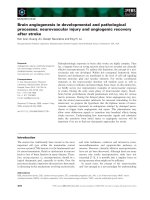Tài liệu Báo cáo khoa học: "MACHINE-READABLE COMPONENTS IN A VARIETY OF INFORMATION-SYSTEM APPLICATIONS" potx
Bạn đang xem bản rút gọn của tài liệu. Xem và tải ngay bản đầy đủ của tài liệu tại đây (84.8 KB, 1 trang )
MACHINE-READABLE COMPONENTS IN A VARIETY OF
INFORMATION-SYSTEM APPLICATIONS
Howard R. Webber
Reference Publishing Division
Houghton-Mifflln Company
2 Park Street
Boston. MA 02108
Components of the machine-readable dictionary can be
applied in a number of information systems. The most direct
applications of the kind are in wordprocessing or in "writing-
support" systems built on a wordprocessing base. However,
because a central function of any dictionary is in fact data
verification, there are other proposed applications in
communications and data storage and retrieval systems.
Moreover, the complete interrelational electronic dictionary is
in some sense the model of the language; and there are,
accordingly, additional implications for language-based
information search and retrieval.
In regard to wordprocessing, the electronic lexicon can serve
as the base for spelling verification (in which the computer
detects many spelling or typographical errors} and spelling
correction (in which the computer offers corrections to the
errors it has identified). Because it is possible to develop
algorithms that permit the computer to calculate the chances
that the single best alternative it offers is actually correct, this
substitution can in many cases be made automatically. It is at
this point in the development of such systems wise to flag such
automatic corrections for inspection by the operator.
At the present time, these processes generally depend upon
the application of strict frequency measures, which permit the
lexicon to be reduced to small-machine proportions and thereby
reduce the possibility of a false hit the passing of a misspelled
common word that happens to coincide in orthography with a
legitimate but rare word. As our ability to draw cognitive
information from text increases, and as available memory
increases, then such limits can be abandoned.
Truncation of the lexicon for other specific applications can
be considered. It is possible, for example, to shape the lexicon
to reflect a children's vocabulary and thereby to develop
spelling correction and other writing aids for the early
educational years on a very small machine base. It is also
possible to shape the lexicon to the needs of the educated adult
user, for whom information about common words is
unnecessary, and thereby to provide an exceptionally rich
resource about "difficult" words within small-machine memory
for on-line access to spelling, definition, and pronunciation.
Configuring the lexicon pyramidally by frequency, including all
words of high frequency, seems an inevitable model to us now,
but it is of course a kind of historical accident.
As many of these comments already make clear, even if one
resolves to work within the linguistic bounds of the ordinary
print dictionary, there are differences in the demands placed
upon the dictionary by print applications and those arising out
of electronic applications. It is a matter of judgment or taste
for the print lexicographer not to include geographic and
biographic terms in the lexicon, but the electronic lexicographer
does not have that latitude.
Access to on-line dictionaries can be by the standard
alphabetic means or by well-developed phonetic algorithms
(which solve the conundrum of needing to know spelling before
being able to find spelling) or by definition (the reverse
dictionary). As electronic citation for words and senses is done
on the basis of machine scans of print-composition tapes and
even of voice scans, then sensitive subject coding should permit
the development of lexicons tailored to the user profile, with
attendant benefits in comprehensiveness and economy of
memory. One can conceive of dictionaries that monitor their
own use and respond by offering only unkown information to
the individual user.
The dictionary that contains synonymy is a resource in the
construction of electronic synonym generators, of which there is
at least one model that returns synonyms in the inflections of
the source words, including phrasal synonyms, taking precise
account of all irregularities in doing so. Presentation of
synonyms is useful for "knowledge workers" but not for clerical
workers.
If usage information is included in the dictionary, then it is
deliverable as a discrete electronic product. The most direct
key to specific usage guidance is by "trigger" words or phrases
that call up guidance information for the operator, but much
more sophisticated implementations are possible when
programming addresses grammar and syntax.
In large-system management, where accuracy of alpha data is
a consideration, the machine dictionary can be the base or one
of the bases for verification and correction of data streams in
communication or of stored data. ~hat I have called the
complete interrelational dictionary-fully coded to reflect the
range of significant linguistic information-will serve as the base
for retrieving information by meaning rather than mechanics.
463









